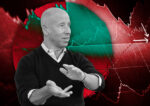Starwood Property Trust in the fourth quarter served up both good and bad news.
The REIT reported higher loss reserves and an uptick in assets taken back by the lender, largely driven by the deteriorating office market.
“There is strain in the real estate markets,” CEO Barry Sternlicht said during a Thursday morning earnings call.
“We are in the ship, we are in the boat, we are navigating these waters, we’re going to take some losses, we’re going to be okay,” Sternlicht said.
A bright spot for the firm: Starwood plans to push in where regional banks have pulled back, launching a middle-market lending arm.
The company reported a $28 million jump in current expected credit loss reserves, a measure of anticipated losses on loans, which hit $307 million in the quarter. Debt backed by office buildings accounts for 74 percent of that loss provision.
The REIT’s dollar volume of REO assets, or properties owned by the lender, grew by $101 million to a total of $172 million.
On the call, Chief Financial Officer Rina Paniry noted planned sales of foreclosed assets that had not panned out: a vacant Downtown Los Angeles office property and another office building in Houston.
In December 2022, Starwood foreclosed on 801 South Broadway , a trophy DTLA office property that Joel Schreiber — WeWork’s first investor — had defaulted on. Starwood acquired the building with a $200 million credit bid, below the building’s $254 million debt. Earlier that year, it had foreclosed on Houston’s Marathon Oil Tower.
The firm had kicked around redevelopment plays for both properties. Starwood CEO Barry Sternlicht in a 2022 earnings call explicitly mentioned an opportunity to convert the Houston tower “to resi [or] sell it to somebody who’s going to do that.”
For both assets, neither plan worked out.
JPMorgan analyst Rick Shane asked if Starwood expected the cash flow from assets it now owned to “come close to replacing what you were generating as lenders.”
“There is cash flow coming out, so the drag is less because of that,” said President Jeffrey Dishner, adding that even with no cash flow, the firm would be able to cover its dividend.
The firm also reported it had categorized a $124 million loan backing an office property outside of Washington, D.C. as non-accruing in the quarter.
“Having these nonaccrual assets is not the greatest position, but to be able to easily cover your dividends is certainly a very comfortable position,” Sternlicht said.
Sternlicht took the better part of four minutes to take the Federal Reserve to task for the widespread pain in commercial real estate.
“The real estate industry didn’t cause this economic situation,” the CEO said. “We were just an unintended consequence.”
Sternlicht noted the Fed had relied on “stale data” for the consumer price index, a measure of inflation, which the Fed has worked to bring down through rate hikes. Rents comprise about one-third of the CPI basket, but the data used to calculate changes in rent growth is collected every six months, which results in a lag.
“When rents were flying, they showed no inflation and now that rents are falling they’re still showing a significant increase in rents,” Strenlicht said.
“It would take a minute for the Fed to call Fannie and Freddie and find out what’s really happening,” he added.
The CEO named regional banks as a “victim” of the Fed’s policy, saying those lenders “cannot stay solvent with these current interest rates, with $1.9 trillion dollars of real estate exposure.”
Regional banks pulled back on lending in the wake of last spring’s three bank failures. The dip, however, has created an opening for non-traditional lenders to step in, and Starwood is joining the mix.
Dishner said the REIT, in a novel play, would dip into the middle-market lending space, focusing on $15-50 million mortgages that “regional banks historically dominated.”
“In terms of opportunity, there are the best opportunities in the middle markets and the smaller loans, which have been cleared out by the regional banks, which are not lending,” Sternlicht said.
The REIT also highlighted that fees from its special servicing arm LNR Partners increased to $14 million in the quarter. Dishner noted the business is “continuing to accelerate” amid expectations that commercial real estate distress will proliferate.
To end the call, Sternlicht took one last swing at the Fed, simultaneously offering a prediction of when rates might drop. He highlighted that borrower’s repayments of senior loans in the quarter, which totaled $805 million, “puts us in really good shape to combat these next eight months of relenting pressure from the Fed.”
Starwood reported earnings of $71 million in the quarter, or 22 cent per diluted share — a 50 percent decline from the same period last year. Revenue clocked in at $522 million, a 15 percent increase from the fourth quarter of 2022.
Read more



